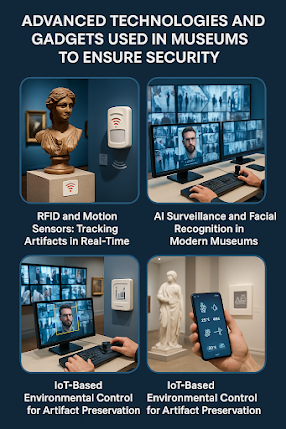Description
Museums today are not just cultural hubs but also high-security zones that protect priceless artifacts, rare paintings, and historical documents. To safeguard these treasures from theft, vandalism, and environmental damage, museums implement a wide range of cutting-edge technologies.
One of the most widely used systems is 24/7 CCTV surveillance, with high-resolution cameras covering every corner. These cameras are often supported by facial recognition software that helps identify suspicious behavior or unauthorized personnel. Motion detectors and infrared sensors are installed to monitor unauthorized movement, especially during non-operational hours.
RFID tagging is another essential tool used to track and monitor the movement of each exhibit. These tags are linked to a central system and alert staff if any object is moved unexpectedly. Some museums also use pressure-sensitive flooring near high-value displays, which triggers alarms if tampered with.
Climate and humidity control systems are integrated with IoT technology to protect sensitive artifacts from environmental damage. Additionally, AI-powered systems analyze visitor behavior patterns to predict and prevent potential security breaches.
Security personnel also carry portable scanning devices and wearables connected to a centralized alert system. All these measures combined ensure that the museum remains a secure, intelligent space for learning and exploration.
Headlines
1. RFID and Motion Sensors: Tracking Artifacts in Real-Time
RFID (Radio Frequency Identification) technology is now widely used in museums to tag and monitor the movement of valuable artifacts. Each item is fitted with a tiny RFID tag that sends signals to receivers throughout the museum. If an item is moved unexpectedly or crosses a restricted zone, an instant alert is triggered to the security team. Similarly, motion sensors detect any unauthorized movement within exhibit areas, especially useful during after-hours when the museum is closed. These combined technologies enable real-time tracking and reduce human error in artifact security.
2. AI Surveillance and Facial Recognition in Modern Museums
Artificial Intelligence (AI) has transformed traditional museum security. Modern surveillance systems are equipped with AI-powered cameras that can analyze real-time video feeds to detect unusual behavior or recognize faces from watchlists. This helps prevent theft, vandalism, or even unauthorized access. AI can distinguish between normal visitor activity and suspicious actions, minimizing false alarms while improving overall security. These systems are also integrated with entry gates and access control to automatically restrict access to sensitive areas.
3. IoT-Based Environmental Control for Artifact Preservation
Aside from theft protection, museums also use technology to preserve artifacts from environmental damage. IoT (Internet of Things) devices monitor and control environmental factors like temperature, humidity, and light exposure. These smart sensors are connected to centralized software that alerts museum staff to any harmful changes in conditions. For example, if humidity levels rise near a paper manuscript or ancient textile, the system will automatically activate dehumidifiers. This ensures long-term preservation of historical items.
🏛️ 1. Museum of Art & Photography (MAP), Bengaluru
-
Technologies Used: Artificial Intelligence (AI), Facial Recognition, Speech Synthesis, Holographic Displays
-
Highlights: MAP has collaborated with Accenture Labs to create India's first AI-enabled conversational digital persona of the artist M.F. Husain. This interactive experience allows visitors to engage in lifelike conversations with a 3D hologram of the artist, enhancing the museum's appeal to younger audiences.
🏛️ 2. National Museum, New Delhi
-
Technologies Used: RFID Tagging, CCTV Surveillance, X-Ray Baggage Scanners, Metal Detectors, Fire Alarm Systems
-
Highlights: Under the Ministry of Culture's initiative, the National Museum has implemented RFID tagging for artworks and upgraded its security systems to include modern technological gadgets, ensuring the safety of its extensive collection.
🏛️ 3. Salar Jung Museum, Hyderabad
-
Technologies Used: RFID Tagging, CCTV Surveillance, X-Ray Baggage Scanners, Metal Detectors, Fire Alarm Systems
-
Highlights: As part of the Ministry of Culture's efforts, Salar Jung Museum has enhanced its security measures by incorporating RFID technology and other modern security apparatus to protect its valuable artifacts.
🏛️ 4. Victoria Memorial Hall, Kolkata
-
Technologies Used: RFID Tagging, CCTV Surveillance, X-Ray Baggage Scanners, Metal Detectors, Fire Alarm Systems
-
Highlights: The museum has been part of the government's initiative to ramp up security arrangements, including the implementation of RFID tagging and other advanced security technologies to safeguard its collections.
🏛️ 5. Pradhanmantri Sangrahalaya, New Delhi
-
Technologies Used: Artificial Intelligence (AI), Augmented Reality (AR), Virtual Reality (VR), Robotics
-
Highlights: This museum offers an immersive experience by integrating AI, AR, VR, and robotics, allowing visitors to engage with India's history and its prime ministers through interactive exhibits.
🏛️ 6. Ram Katha Museum, Ayodhya
-
Technologies Used: Artificial Intelligence (AI), Augmented Reality (AR), Virtual Reality (VR)
-
Highlights: The museum has adopted immersive technologies to enhance visitor engagement, aiming to increase daily foot traffic by providing interactive and educational experiences related to the Ramayana.
"This Content Sponsored by Buymote Shopping app
BuyMote E-Shopping Application is One of the Online Shopping App
Now Available on Play Store & App Store (Buymote E-Shopping)
Click Below Link and Install Application: https://buymote.shop/links/0f5993744a9213079a6b53e8
Sponsor Content: #buymote #buymoteeshopping #buymoteonline #buymoteshopping #buymoteapplication"






No comments:
Post a Comment